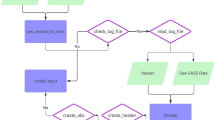Abstract
Geomagnetic observatory data are fundamental in geomagnetic field studies and are widely used in other applications. Often they are combined with satellite and ground survey data. Unfortunately, the observatory definitive data are only available with a time lag ranging from several months up to more than a year. The reason for this lag is the annual production of the final calibration values, i.e. baselines that are used to correct preliminary data from continuously recording magnetometers. In this paper, we will show that the preparation of definitive geomagnetic data is possible within a calendar year and presents an original method for prompt and automatic estimation of the observatory baselines. The new baselines, obtained in a mostly automatic manner, are compared with the baselines reported on INTERMAGNET DVDs for the 2009–2011 period. The high quality of the baselines obtained by the proposed method indicates its suitability for data processing in fully automatic observatories when automated absolute instruments will be deployed at remote sites.







Similar content being viewed by others
References
Clarke E, Baillie O, Reay SJ, Turbitt CW (2013) A method for the near real-time production of quasi-definitive magnetic observatory data. Earth Planets Space 65(11):1363–1374. doi:10.5047/eps.2013.10.001
De Boor C (1978) A practical guide to splines. Springer, New York
De Boor C (2003) Spline toolbox for use with MATLAB, The MathWorks, Inc
Friis-Christensen E, Lühr H, Hulot G (2006) Swarm: a constellation to study the Earth’s magnetic field. Earth Planets Space 58(4):351–358. doi:10.1186/BF03351933
Gonsette A, Rasson J, Marin JL (2013) AUTODIF: automatic absolute DI measurements. In: Proceedings 15th IAGA Workshop on Geomagnetic Observatory Instruments, Data Acquisition, and Processing, Boletin ROA, No. 03/13, 16–19
Jankowski J, Sucksdorff C (1996) Guide for magnetic measurements and observatory practice. International Association of Geomagnetism and Aeronomy, Boulder
Korte M, Mandea M, Linthe HJ, Hemshorn A, Kotzé P, Ricaldi E (2009) New geomagnetic field observations in the South Atlantic Anomaly region. Ann Geophys Italy 52(1):65–81
Korte M, Brunke HP, Bronkalla HP, Pulz E (2013), Status of the geomagnetic automated system GAUSS. In: Proceedings 15th IAGA Workshop on Geomagnetic Observatory Instruments, Data Acquisition, and Processing, Boletin ROA, No. 03/13, 20–23
Lesur V, Macmillan S, Thomson AWP (2006) Deriving main field and secular variation models from synthetic Swarm satellite and observatory data. Earth Planets Space 58(4):409–416. doi:10.1186/BF03351937
Macmillan S, Olsen N (2013) Observatory data and the Swarm mission. Earth Planets Space 65(15):1355–1362. doi:10.5047/eps.2013.07.011
Mandea M, Korte M (2011) Geomagnetic Observations and Models, IAGA Special Sopron Book Series, Springer, Dordrecht, DOI: 10.1007/978-90-481-9858-0
Mandić I, Vujić E, Heilig B, Pelajić I, Herak D (2016) Recent efforts toward the establishment of the Lonjsko Polje geomagnetic observatory. Acta Geophys 64(5):1311–1339. doi:10.1515/acgeo-2016-0051
Matzka J (2013) Preparation of quasi definitive (QD) data for the observatories Narsarsuaq, Qeqertarsuaq and Tristan Da Cunha. In: Proceedings 15th IAGA Workshop on Geomagnetic Observatory Instruments, Data Acquisition, and Processing, Boletin ROA, No. 03/13, 50–53
Olsen N, Haagmans R, Sabaka TJ, Kuvshinov A, Maus S, Purucker ME, Rother M, Lesur V, Mandea M (2006) The swarm end-to-end mission simulator study: a demonstration of separating the various contributions to Earth’s magnetic field using synthetic data. Earth Planets Space 58(4):359–370. doi:10.1186/BF03351934
Peltier A, Chulliat A (2010) On the feasibility of promptly producing quasi-definitive magnetic observatory data. Earth Planets Space 62(2):e5–e8. doi:10.5047/eps.2010.02.002
Steiner F (1988) Most frequent value procedures. Geophys Trans 34(2–3):139–260
St-Louis B (2012) Intermagnet technical reference manual (Version 4.6)
Acknowledgements
We would like to thank two anonymous reviewers for constructive suggestions that helped us to improve the quality of the paper. The results presented in this paper rely on the data collected at magnetic observatories. We thank the national institutes that support them and INTERMAGNET for promoting high standards of magnetic observatory practice (http://www.intermagnet.org). This work was supported by the DAAD (No. 91529536-50015537) and ERASMUS (No. ERA-2013-166) exchange programme.
Author information
Authors and Affiliations
Corresponding author
Rights and permissions
About this article
Cite this article
Mandić, I., Korte, M. On the possibility of producing definitive magnetic observatory data within less than one year. Acta Geophys. 65, 275–286 (2017). https://doi.org/10.1007/s11600-017-0026-9
Received:
Accepted:
Published:
Issue Date:
DOI: https://doi.org/10.1007/s11600-017-0026-9




